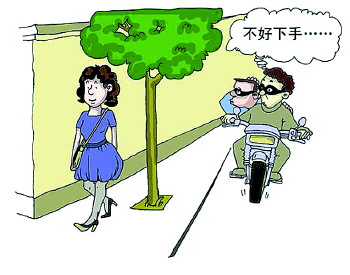
|
The way people move can influence the likelihood of an attack by a stranger. The good news, though, is that altering it can reduce the chances of being targeted. "The power has gone to his head" is an oft-heard accusation. So are leaders losing touch with reality when they act in a power-hungry way? How you move gives a lot away. Maybe too much, if the wrong person is watching. We think, for instance, that the way people walk can influence the likelihood of an attack by a stranger. But we also think that their walking style can be altered to reduce the chances of being targeted. A small number of criminals commit most of the crimes, and the crimes they commit are spread unevenly over the population: some unfortunate individuals seem to be picked out repeatedly by those intent on violent assault. Back in the 1980s, two psychologists from New York, Betty Grayson and Morris Stein, set out to find out what criminals look for in potential victims. They filmed short clips of members of the public walking along New York's streets, and then took those clips to a large East Coast prison. They showed the tapes to 53 violent inmates with convictions for crimes on strangers, ranging from assault to murder, and asked them how easy each person would be to attack. The prisoners made very different judgements about these notional victims. Some were consistently rated as easier to attack, as an "easy rip-off". There were some expected differences, in that women were rated as easier to attack than men, on average, and older people as easier targets than the young. But even among those you’d expect to be least easy to assault, the subgroup of young men, there were some individuals who over half the prisoners rated at the top end of the "ease of assault" scale (a 1, 2 or 3, on the 10 point scale). The researchers then asked professional dancers to analyse the clips using a system called Laban movement analysis – a system used by dancers, actors and others to describe and record human movement in detail. They rated the movements of people identified as victims as subtly less coordinated than those of non-victims. Although Professors Grayson and Stein identified movement as the critical variable in criminals' predatory decisions, their study had the obvious flaw that their films contained lots of other potentially relevant information: the clothes the people wore, for example, or the way they held their heads. Two decades later, a research group led by Lucy Johnston of the University of Canterbury, in New Zealand, performed a more robust test of the idea. The group used a technique called the point light walker. This is a video recording of a person made by attaching lights or reflective markers to their joints while they wear a black body suit. When played back you can see pure movement shown in the way their joints move, without being able to see any of their features or even the limbs that connect their joints. Research with point light walkers has shown that we can read characteristics from joint motion, such as gender or mood. This makes sense, if you think for a moment of times you've recognised a person from a distance, long before you were able to make out their face. Using this technique, the researchers showed that even when all other information was removed, some individuals still get picked out as more likely to be victims of assault than others, meaning these judgements must be based on how they move. Walk this way But the most impressive part of Johnston’s investigations came next, when she asked whether it was possible to change the way we walk so as to appear less vulnerable. A first group of volunteers were filmed walking before and after doing a short self defence course. Using the point-light technique, their walking styles were rated by volunteers (not prisoners) for vulnerability. Perhaps surprisingly, the self-defence training didn't affect the walkers’ ratings. In a second experiment, recruits were given training in how to walk, specifically focusing on the aspects which the researchers knew affected how vulnerable they appeared: factors affecting the synchrony and energy of their movement. This led to a significant drop in all the recruits' vulnerability ratings, which was still in place when they were re-tested a month later. There is school of thought that the brain only exists to control movement. So perhaps we shouldn't be surprised that how we move can give a lot away. It's also not surprising that other people are able to read our movements, whether it is in judging whether we will win a music competition, or whether we are bluffing at poker. You see how someone moves before you can see their expression, hear what they are saying or smell them. Movements are the first signs of others’ thoughts, so we've evolved to be good (and quick) at reading them. The point light walker research a great example of a research journey that goes from a statistical observation, through street-level investigations and the use of complex lab techniques, and then applies the hard won knowledge for good: showing how the vulnerable can take steps to reduce their appearance of vulnerability. |
人们走路的方式可能会影响被陌生人袭击的几率。但好消息是通过改变走路方式,能够降低被抢几率。 你走路的方式能透漏很多信息。对一些不法分子来讲,甚至是过多的信息。例如,我们认为人们走路的方式可能会影响被陌生人袭击的几率,但是可以通过改变走路方式来降低此几率。 大部分的犯罪行为是由少数犯罪分子做的,而受害者也十分分散,分布不均:有一些人很不幸,似乎总是成为蓄意暴力袭击的目标。追溯到上世纪80年代,来自纽约的两名心理学家贝蒂·格雷森(Betty Grayson)和莫里斯·斯坦因(Morris Stein)开始研究什么的样的人是罪犯所寻找的潜在受害者。他们将在纽约大街上独自行走的路人拍摄下来,送到东海岸的大监狱,将其展示给53名曾因袭击陌生人入狱的暴力囚犯。他们的袭击行为轻重不一,从侮辱到谋杀。并询问他们每个路人易被攻击的程度。 囚犯对这些假定受害者评价不一。有些人总被指出很容易被抢。其中有一些是之前预料到的结果。比如,囚犯认为女士比男士更容易被袭击,老年人比年轻人更易成为目标。但即使在通常认为很难被攻击的男性中,也有一些人被超过半数的囚犯标为极容易被抢。(在10分制标准中,他们仅得1、2或3分) 研究人员邀请专业的舞蹈家用拉邦动作分析理论(Laban movement analysis)来研究这些短片中的行人。这一理论常被舞蹈家、演员以及其他人员用来描述和记录人类运动的细节。他们指出,那些容易成为攻击对象的人的运动与其他人相比略微不协调。 虽然格雷森与斯坦因教授将人们的行动方式视为罪犯决定采取行动的关键条件,但他们的研究有明显的漏洞。在视频中,有很多潜在的相关信息,例如人们的着装、抬头的方式等。20年后,由露西·约翰斯顿(Lucy Johnston)领导的一个坎特伯雷大学研究小组在新西兰对此想法进行了更有力的测试。 他们利用了光点式步行者技术(point light walker)。被观察者要身着一身黑衣,并将光源或标记物附在他们的关节上进行录像。当回放时,你只能看到关节的运动,不会受其他身体部位甚至是四肢的干扰。 光电步行者技术的调查显示,我们可能从关节的运动判断一个人的性别和心情。这是很有道理的,你可以思考一下,当你想认清远处走来的一个人,在你看到他们的面容之前,你是怎么样做的。利用此项技术研究人员表明,即使其他的信息都被过滤掉,某些人与其他人相比仍然更容易被视为攻击的受害者。这就意味着这些判断是根据他们的运动方式。 试试这样走路 约翰斯顿最令人注目的调查是她对是否可以通过改变走路方式降低被袭击的几率的研究。她对第一组研究对象上防御课前后进行了录像。利用光点式步行者技术,志愿者们(不是囚犯)对这些研究对象的易伤性进行了打分。但出人意料,自卫训练并没有影响他们的打分。 在第二组实验中,对研究对象给予走路姿势的训练,特别专注于那些调查人员已知的会影响他们易伤性的方面,即他们运动的协调性和力量方面。这在打分中大大降低了他们成为受害者的概率。一个月后,对他们再次进行测试,结果依然如此。 有一派学者认为,大脑的存在是为了控制运动。因此对于我们的走路方式可能会透漏很多信息这一点,我们不应感到太过惊讶。在判断我们能否赢得音乐比赛、打牌时是不是在虚张声势时,别人能读懂我们的运动也是很正常的。在看到别人的表情前,听到他们的声音亦或是闻到他们的气味前,我们总能看到他们的运动方式。运动是他人思想的第一个标识,因此我们进化到有能力很快地读懂他们。 光点式步行者技术调查法是一个通过街头调查以及复杂的实验技术逐步从统计观察运用到实践的很好的研究例证,展示出弱者如何一步一步降低其易伤性的过程。 扫一扫,关注微博微信
  (译者 heyjings 编辑 齐磊) |
|
|
